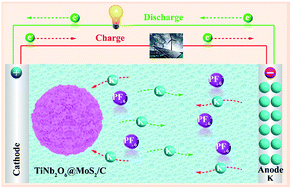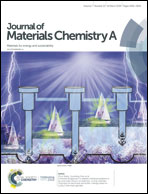Carbon-encapsulated ultrathin MoS2 nanosheets epitaxially grown on porous metallic TiNb2O6 microspheres with unsaturated oxygen atoms for superior potassium storage†
Abstract
Rechargeable potassium-ion batteries (KIBs) have emerged as promising alternatives to lithium-ion batteries (LIBs) in large-scale applications due to the abundant and low-cost potassium resources. To date, only a few suitable potassium storage materials have been reported due to the large-sized potassium ions and sluggish kinetics. Herein, we design a three-layered heterostructure with porous metallic TiNb2O6 as the core and carbon-encapsulated MoS2 nanosheets as the shell (denoted as TiNb2O6@MoS2/C) as an advanced anode for KIBs. This hybrid configuration can significantly enhance the electronic conductivity from the interior to the exterior by virtue of the oxygen-atom-unsaturated metallic TiNb2O6 core. Furthermore, the amorphous carbon shell plays a crucial role to inhibit the particle agglomeration, accommodate the volume expansion and protect the active material from pulverization because of the three-layered heterostructure. As a result, impressive electrochemical behavior with high capacity (424 mA h g−1 at 0.1 A g−1 after 50 cycles) and high cycling stability (175 mA h g−1 at 1.0 A g−1 after 300 cycles) is achieved. This work opens the door for designing highly conductive heterostructures for energy storage devices.



 Please wait while we load your content...
Please wait while we load your content...